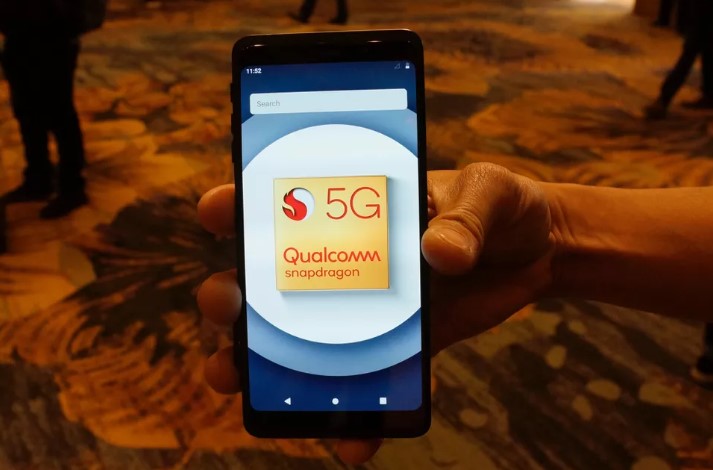
You’d never know by looking at the brick-like phone that it’s one of the fastest devices on the planet. The generic-looking handset is a prototype design that Qualcomm made to showcase 5G, but it — and another prototype made by Samsung — prove that the age of 5G phones and networks is coming fast.
Qualcomm, alongside partners Samsung, Verizon and AT&T, came to the Snapdragon Technology Summit this week in Maui, Hawaii, where they all talked up their plans for 5G in 2019. But Samsung and the networks did more than just talk. Verizon and AT&T set up mini 5G networks to power some demos, and Samsung showed off an early, but working, prototype of a 5G phone in a dock to run a demo at its own booth. The 350 journalists in attendance weren’t given an opportunity to try out the devices, but we did get a chance to see them.
5G “will lay the foundation for smartphones, later cars and virtually every electronic device that will be connected,” Qualcomm president Cristiano Amon said during a keynote. “That first step [smartphones] is getting to us in the first half of 2019.”
The next generation of cellular technology, 5G is expected to significantly boost the speed, coverage and responsiveness of wireless networks. It can run between 10 and 100 times faster than your typical cellular connection today, and even quicker than anything you can get with a physical fiber-optic cable going into your house. It will also connect a device to the network faster, with speeds as quick as a millisecond to start your download or upload.
The overall speed gains mean that phones will be better equipped to handle complex computing tasks in a fraction of the time they currently take. This could make possible advanced photography skills, artificial intelligence actions and augmented reality apps, all of which would take far too long to process on today’s phones. 5G technology will also allow driverless cars and buses to talk to each other and with things like smart streetlights.
While 5G technology will put more-capable devices in your hands, it also presents an opportunity for device makers and carriers to profit. 5G requires specialized hardware, so it won’t just work in any city, or with your current phone. The service providers with the largest 5G networks, and handset makers with the most feature-packed 5G phones, hope to snatch customers as rival carriers and brands struggle to catch up. 5G service plans and 5G-ready phones could also sell for a premium alongside “regular” LTE plans and devices.
On Monday, Samsung and Verizon announced their first 5G “phone,” a proof-of-concept device revealed ahead of the summit. Samsung plans to launch a 5G phone for both Verizon and AT&T networks in early 2019. And earlier this year, Motorola and Verizon teamed up on a 5G-ready module that snaps on to a $400 device, the Moto Z3. Neither will work until Verizon officially lights up its first US 5G networks, but when it does, these phones will be waiting.
Although 5G technology will replace today’s 4G LTE networks, the transition will be gradual. Carriers will roll out their first 5G networks city by city, while also making existing 4G LTE networks faster. Expect larger cities to get 5G first, and rural markets to see the least support early on.
The rocky road to 5G in mid- to late 2019
Transitioning to a 5G network will come with its own set of challenges. First, the operators need to prepare their networks to handle 5G. This fifth-generation data pipeline uses a different part of the wireless spectrum than 4G. It relies on high-frequency millimeter wave (mmWave) to deliver high speeds at short range and sub-6 GHz spectrum to deliver data more broadly, and into buildings.
As with 4G and 3G before it, carriers buy the rights to use spectrum at auctions put on by the FCC. That might mean that some carriers will have more spectrum than others, and that can affect the overall network speed in different parts of the country.
Second, device makers need to make sure their phones work seamlessly with 5G. Phones have to use a specialized modem and dedicated processor that support 5G. Brands such as Samsung, Apple and LG already test every single device on every major carrier they sell through. 5G certification is yet another lengthy, and expensive, process.
But Amon and wireless partners like Verizon on Tuesday said they’re confident about launching phones in early 2019.
“We’re full speed ahead on 5G mobile service,” Nicki Palmer, chief network engineering officer and head of wireless networks at Verizon, said Tuesday at the Qualcomm event. Verizon plans to set up 5G incubators in Los Angeles, the Bay Area and Washington, DC, to target specific uses for the fast networks, she said.
And Amon noted that it isn’t just US carriers or certain wireless companies in other countries that will launch 5G next year. Instead, all major markets across the globe are aiming to introduce 5G as quickly as they can.
“5G is so important that the entire industry is moving at the same pace for 2019 launches,” Amon said. “The fact that we have a mature mobile environment [means]… the development system is going to move faster than ever before.”